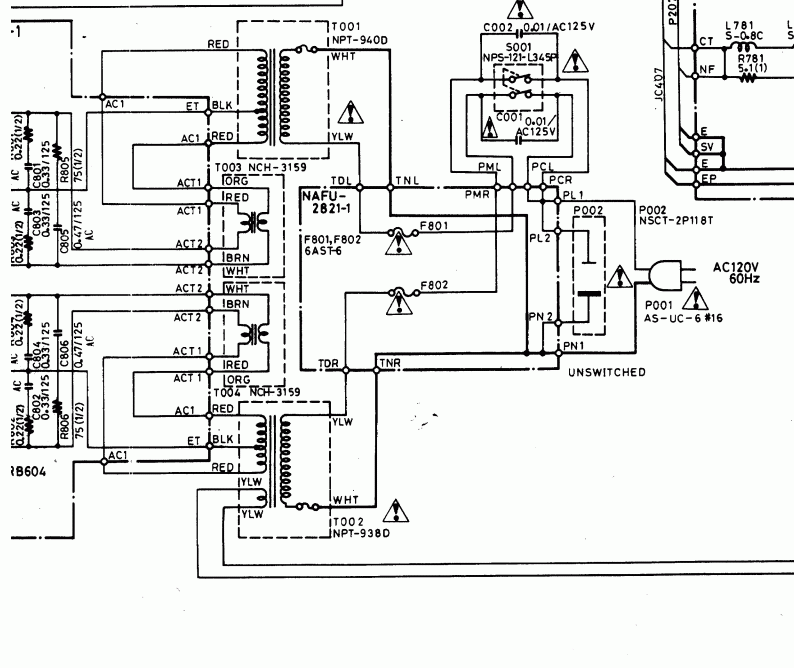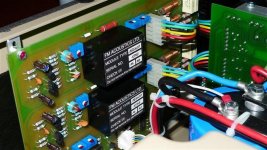A. W.
m = milli = 10^-3, u = µ = micro = 10^-6.
No confusion there.
The confusion is, I believe, in the use of capacitance per rail, per channel.
I got the impression one was stating <=50mF/rail/ch, whereas you were stating
m = milli = 10^-3, u = µ = micro = 10^-6.
No confusion there.
The confusion is, I believe, in the use of capacitance per rail, per channel.
I got the impression one was stating <=50mF/rail/ch, whereas you were stating
I have never seen an "highend" amplifier with less than 50000 uf in the PSU
Mr Wayne,
Meitner amp (is Class AB) =>
That's a rare one 🙂
I have never personally seen inductors inside an A/B production amplifer before, advantages ...?
PS: Looks like a good tweeter amp .... 🙂
Last edited:
The L in a an rCLC PSU reduces mains interference feeding into the amplifier.
It also reduces the rectifier noise trying to feed in with the interference.
It also reduces the rectifier noise trying to feed in with the interference.
seen inductors inside an A/B production amplifier before ?
More exotic choke power supply examples, which may sound less rare to you ;
- Cello, e.g. Performance, Encore.
- Viola, Bravo model.
- From fellow forum member Mr Gerhard, bass amp for the Cerubin loudspeaker.
Example of a current production power amp with regulated output stage rails (capacitance multiplier), Orpheus Privilege.
(I was informed recently that the Sanken regulated amp got booted to obsolete stage. As the Omega man is retiring in a couple of years also, all good things come to another end)
The L in a an rCLC PSU reduces mains interference feeding into the amplifier.
It also reduces the rectifier noise trying to feed in with the interference.
How is the value determined ...?
More exotic choke power supply examples, which may sound less rare to you ;
- Cello, e.g. Performance, Encore.
- Viola, Bravo model.
- From fellow forum member Mr Gerhard, bass amp for the Cerubin loudspeaker.
Example of a current production power amp with regulated output stage rails (capacitance multiplier), Orpheus Privilege.
(I was informed recently that the Sanken regulated amp got booted to obsolete stage. As the Omega man is retiring in a couple of years also, all good things come to another end)
Interesting , so why not more common place Dutchie ...?
Might be more accurate to state the max allowable ripple level on the rails, and at which load, for "high end" amps.
Or explain why PS capacitance should go up linearily with power instead of the sqrt of output power.
(device Vce at least 125% higher than max supply rail voltage)
Yes, you can of course quote it in terms of ripple voltage for a given load. LTspice very useful for this kind of analysis.
Like all of these things, there is no right way or wrong way up to a certain point. If you are designing an amp, you get to decide the parameters.
"I guess you discount new switchmode for audio technology then? I recommend you watch this space, some of these things are starting to do extremely well. I just bought my first pair to try and it took some convincing let me tell you. fully regulated 500W using what is basically a. . . "
I think they can me quite good if you use the right topology.
I think they can me quite good if you use the right topology.
"So you have not done any subjective analysis regarding added capacitance in the psu ...? "
During development of my earlier power amp, I tried it on 6800uF per rail. Going to 34000uF per rail seems to improve the subjective sound. I did not repeat his experiment on the latest amp since I tested the amp with the final PSU.
During development of my earlier power amp, I tried it on 6800uF per rail. Going to 34000uF per rail seems to improve the subjective sound. I did not repeat his experiment on the latest amp since I tested the amp with the final PSU.
so why not more common place ?
Cost, market, designer's philosophy.
Same cash pays for a higher output amp.
More efficient, designer happy.
More power, customer happy.
More efficient and more power, higher sales, company happy.
Here are some of the inductors in the power supply of FM Acoustics FM1811.
Ahhh, Love the way Huber packages it 🙂 I guess i would do mine like that ....................

What about the mains power cable. Integrated with the amplifier or detachable?
Detachable using IEC socket with integrated fuse holder and power switch!
Have you ever worked on a Crown? My Com-tech 400 is laid out very well and only high quality components are used.
I have a pair of Crown D-75's that I have modified. I think they are pretty good quality. The transformers buzz, but that's apparently not unusual for pro gear. My dbx crossover buzzes also, and it's brand new.
migration of electrolyte in a vertical position is calculated thing there is enough inside to cover the plates
That doesn't appear logical. If there's enough to fill up the can in the vertical position, then mounting it horizontally cannot make any difference. If you fill up a glass with water, seal the top, and then place it horizontally, the water will not "migrate" to the bottom side of the glass.
Here is an example of an amplifier that eventhough made almost 15 years ago preserve some rules that a lot of people scream about in our forum for many years ( for people that manufacture and construct ) and the amp it shelf sets a level of perfection in amplifier construction .
kind regards
sakis
I see a huge number of potential problems with this amplifier, from the use of Fastons for signal wires, to screw terminals for power leads, to various other quick disconnect fittings on the circuit boards. All of these kinds of connectors can cause a relatively high resistance, or in the case of the screws, work loose. Heat cycling for example can make screws come loose. Any connection that's important to me gets soldered.
- Status
- Not open for further replies.
- Home
- Amplifiers
- Solid State
- HOW TO MAKE A PROPER AMPLIFIER


